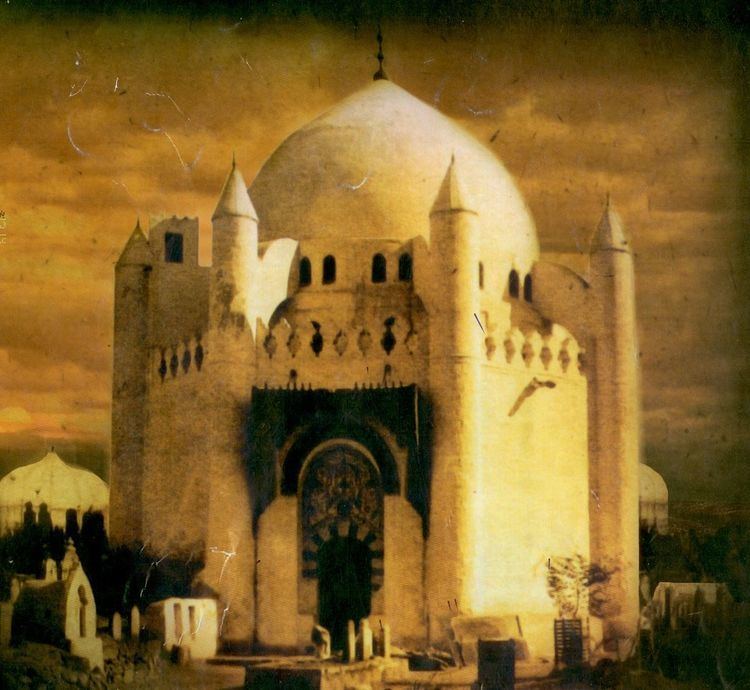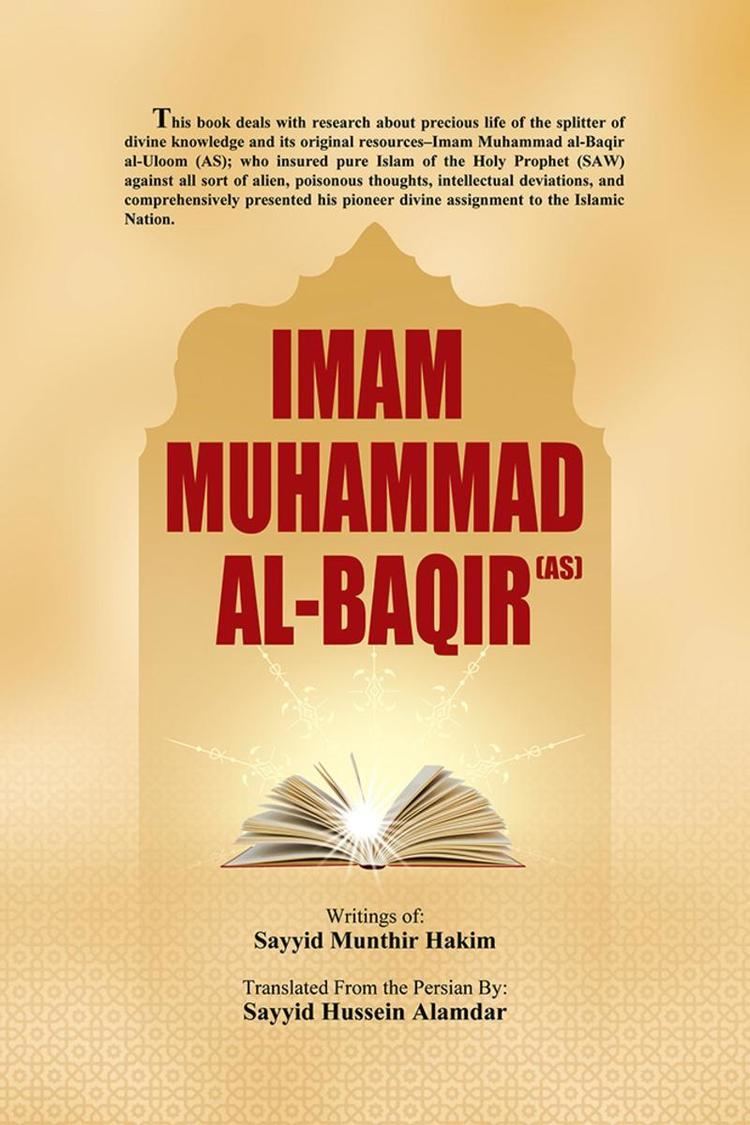Ethnicity `Arab (Banu Hashim) Name Muhammad al-Baqir | Role Imam Siblings Zayd ibn Ali | |
 | ||
Native name محمد بن علي الباقر (Arabic) Cause of death Death by poisoning according to most Shi'a Muslims Resting place Jannatul Baqi, Saudi Arabia24°28′1″N 39°36′50.21″E / 24.46694°N 39.6139472°E / 24.46694; 39.6139472 Other names Muhammad ibn ‘Ali ibn Husayn Title Listal-Baqir(Arabic for Revealer)Besinci Ali(Turkish for Fifth Ali) Died 743 AD, Medina, Saudi Arabia Children Ja'far al-Sadiq, Zaynab bent Muhammad al-Baqir Parents Fatimah bint Hasan, Ali ibn Husayn Zayn al-Abidin Similar People | ||
06 biography of imam baqir as sayed ammar nakshawani ramzan 1432ah 2011
Muḥammad al-Baqir, full name Muhammad bin 'Ali bin al-Husayn bin Ali bin Abi Talib, also known as Abu Ja'far or simply al-Baqir (Arabic: محمد الباقر, al-Bāqir) (677-733) was the fifth Shia imam, succeeding his father Zayn al-Abidin and succeeded by his son Ja'far al-Sadiq. He was the first imam descended from both grandsons of Muhammad: Hasan ibn Ali and Husayn ibn Ali. He is revered by Shiite Muslims for his religious leadership, and respected by Sunni Muslims for his knowledge and Islamic scholarship as a jurist in Medina.
Contents
- 06 biography of imam baqir as sayed ammar nakshawani ramzan 1432ah 2011
- Birth of imam muhammad al baqir a s the divine knowledge of imams a s
- Birth and early life
- Name
- Imamate
- Division
- Under the Umayyad rulers
- Maathirul Baqir
- Umm al Kitab
- Tafsir al Baqir
- Selected sayings
- Death
- References

Birth of imam muhammad al baqir a s the divine knowledge of imams a s
Birth and early life
Al-Baqir had a prominent lineage, his paternal and maternal grandfathers, Husayn ibn Ali and Hasan ibn Ali, were Muhammad's grandsons: His father was Ali ibn Husayn Zayn al-Abidin (son of Husayn, the second son of Ali) and his mother, Fatima Umm Abd Allah, was a daughter of al-Hasan (the first son of Ali).
Al-Baqir was born in Medina around 56 AH (676 AD), when Muawiyah I was trying to ensure that his son Yazid I could inherit the caliphate. When Al-Baqir was a child, his family was affected by the Battle of Karbala; he was three or four years old when his grandfather, Husayn, was killed.
According to Ya'qubi, al-Baqir was present at Karbala. In his youth he witnessed the struggle for power among the Umayyads, Abd Allah ibn al-Zubayr and a number of Shiite parties, whilst his father maintained a distance from local political activity.
Name
Al-Baqir is an abbreviation of Baqir al-'ilm, which means "he who opens knowledge", and al-Baqir is said to have been known for his knowledge. According to Ibn Khallikan, he received the nickname "al-Baqir" (the ample) due to the "ample fund of knowledge" he collected. However, Ya'qubi believed that he was called al-Baqir because he "split open knowledge", examining its depths. The Shiites believe that Baqir al-'ilm was not an ordinary title, because it was given to him by Muhammad. According to al-Kulayni, Muhammad's only living companion Jabir ibn Abd Allah would sit in the mosque and cry: "Ya baqir al-ilm, Ya baqir al-ilm". Although Medinans thought that Jabir was insane, he assured them that Muhammad had told him: "O Jabir! You will meet a man from my family who will have the same name and the same characteristics as mine. He will split open knowledge extensively." According to al-Kulayni, Jabir ibn Abd Allah met al-Baqir when passing a Quran school. Abd Allah saw that the imam was still a child, and examined him to see if he had the features which Muhammad had described. Jabir asked, "Characteristics of the Messenger of Allah; by Him in whose hands is my soul, O boy, what is your name?" When al-Baqir answered that he was Muhammad ibn Ali ibn al-Husayn, Jabir "approached him, kissed his head and swore by his father and mother that Muhammad had recited greeting upon him."
Imamate
During the imamah of Muhammad al-Baqir, riots erupted throughout the Islamic world due to the Umayyad Caliphate's oppression. Disagreements within the Umayyad party kept them occupied, and they left members of the household undisturbed for some time. However, tyranny in the Battle of Karbala had attracted many people to the imams. These conditions had permitted people (particularly the Shiites) to travel to Medina in large groups and visit the imam freely. The possibility of spreading Islam (which had not existed for the previous imams) was available to the fifth imam, indicated by a number of traditions about the imam and scholars trained under him.
Division
After the death of Ali ibn Husayn Zayn al-Abidin (the fourth Imam), most of the Shiites agreed upon his son al-Baqir as the next imam; a minority favored another son of the imam (Zayd ibn Ali), and became known as Zaidiyyah. According to Ibn Khallikan, Zaid (Muhammad al-Baqir's brother), appealed for people to support his cause. According to Al-Masudi, he asked for advice from Muhammad al-Baqir; al-Baqir advised him not to rely on the people of Kufa, explaining how they had previously behaved toward the members of his household. Zaid did not listen to his brother's advice, and led the people of Kufa in a fruitless riot.
According to Al-Shahrastani, a dispute had arisen between Muhammad al-Baqir and Zaid because Zaid had been following the Mu'tazilite Wasil ibn Ata. Zaid had also announced that the position of imam was conditional on his appearing publicly to assert his rights. Muhammad al-Baqir replied, "Your faith then is merely in your father, as such, for according to your theory he was not an imam, for he certainly never came forth to assert his claims."
Under the Umayyad rulers
Despite his non-involvement in political activities, the Umayyad rulers harassed Muhammad al-Baqir. Many Shia individuals and delegations came to Medina from Kufa to hear al-Baqir's teachings and ask him questions, among which was who had the right to rule. He was also distrusted because of the uprising of his brother Zayd ibn Ali and other relatives.
Caliph Hisham ibn Abd al-Malik made a pilgrimage to Mecca, where Mohammed al-Baqir and his son Ja'far al-Sadiq were present. At a gathering, al-Baqir delivered a sermon: "We are the favorite and chosen servants of God, and His vicegerents on the face of the earth. One who obeys us is successful and one who opposes would be evil and wretched." His statements were conveyed to Hisham, who wrote to the governor of Medina when he returned to his court in Syria instructing him to send al-Baqir and his son to Damascus. When they arrived, he kept them waiting for three days; on the fourth he called them to court, where he was practicing archery with his officials.
Ma'athiru'l-Baqir
In Ma'athiru'l-Baqir the imam discussed a number of topics, from the nature of the soul and the qualities of the Ulama to the attributes of God and the divine nature (explaining that it was impossible for humans to understand it). A man asked him, "Should I think of anything (to understand Allah)?" The imam replied: "Yes, but you have to imagine a thing which the mind cannot contain and which is without limit. He is unlike whatever comes into your mind. Nothing resembles Him nor can any thought reach Him." He also said, "Talk about the creation of Allah, but do not talk about Allah Himself, for that increases the owner of the talk nothing except perplexity." He defined a Rasul as a prophet who hears and sees the angel in bodily form or in a dream. A Nabi is a prophet who hears but does not see the angel, and the imam is like the Nabi. The imam was frequently asked to explain teachings about the imamate, which is also explained in Ma'athiru'l-Baqir (a summary of which is translated into English in Canon Sell's Ithna ʻAsharíyya or The Twelve Shiʻah Imams.
Umm al-Kitab
Umm al-Kitab, or The Archetype of the Book, is in the form of a discussion between the imam and three companions. Resembling the Infancy Gospel of Thomas, it illustrates the similarity between imamology and gnostic Christology. A major concept of this work is the description of the numinous experience. Its central motif is the psychological and philosophical explanation of spiritual symbols, with believers instructed to perform acts of self-purification and renewal. Colors are used to symbolize theories and levels of consciousness which one must recognize in oneself.
Tafsir al-Baqir
Tafsir al-baqir, or Tafsir Abul Jaroud, is al-Baqir's exegesis of the Quran. Ibn al-Nadim included this book in his list of exegeses of the Quran in his Kitab al-Fihrist, writing that Abul Jaroud Ziyad ibn Abi Ziyad (the head of the Jarudiyya) reported al-Baqir's book. According to Sayyd Hasan al-Sadr, "A group of the reliable Shiites reported the book from him [Abul Jaroud] from the days of his righteousness"; among them was Abu Basïr Yahya bin al-Qasim al-Asadi. Ali bin Ibrahï~m bin Hashim al-Qummi also mentioned it in his book, al-Tafsïr, by the authority of Abu Basïr.
Selected sayings
Death
The cause and the time of the death of the fifth imam are unclear. According to some accounts al-Baqir was poisoned by Ibrahim ibn Walid ibn Abdallah, the nephew of Hisham. According to the Shiite account, the caliph gave Zaid a saddle treated with poison; Zaid gave it to the imam, who used it and died from the poison. Al-Baqir was laid to rest under the dome in Jannatul Baqee where the imams Hasan ibn Ali and Zayn al-Abidin were buried.
